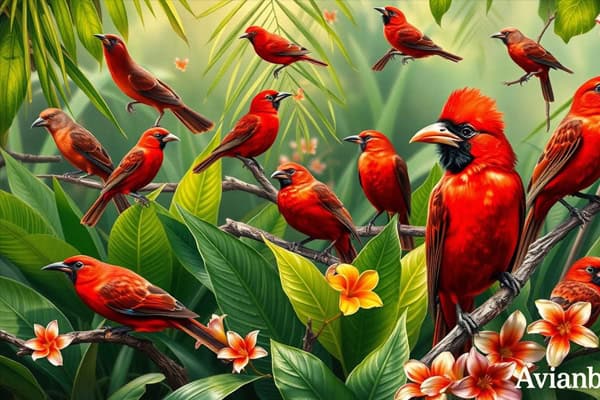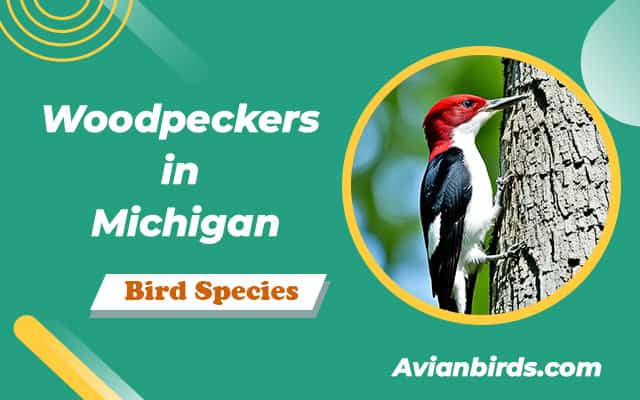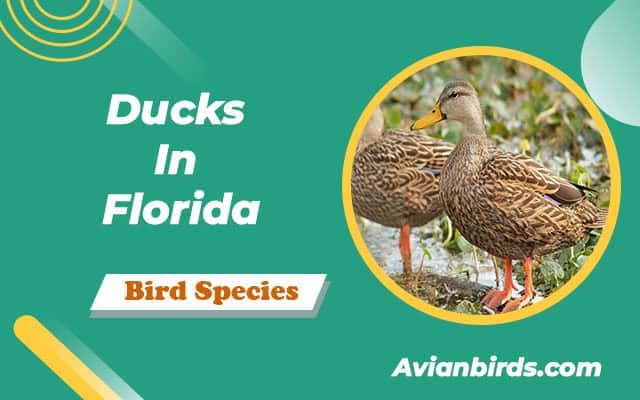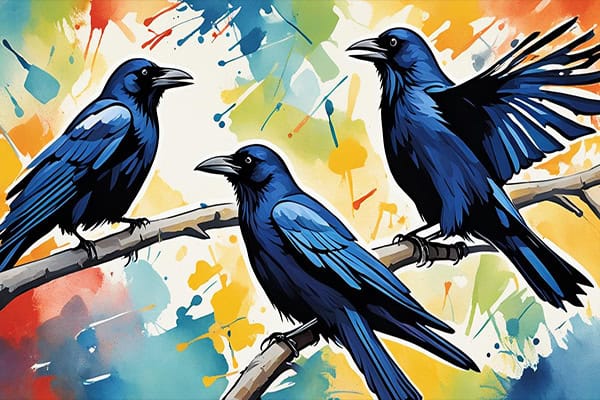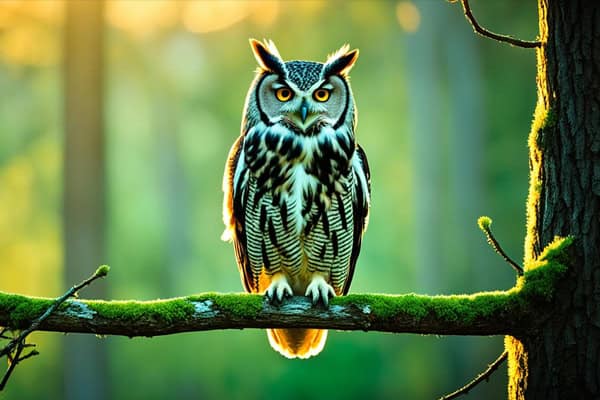Red Birds in Florida (Top 10 Species) With Pictures
Did you know Florida has over 500 birds of species, with about 25 of them being red? This makes Florida a paradise for those who love birdwatching. It’s also a great place to learn about red birds. We’ll look at the top 10 red birds in Florida, including their looks, where they live, and what they eat.
This will help us learn more about these beautiful birds and improve our birdwatching trips. We’ll use pictures and important facts to make it fun and informative.
Introduction to Red Birds in Florida
Florida is a dream spot for bird lovers, with over 550 bird species. These include wetlands, forests, and coastal birds. Red birds are especially eye-catching with their bright colors. They stand out against the state’s green landscapes.
Join us as we explore Florida’s red bird species. We’ll learn about their unique traits and behaviors. These birds add beauty and wonder to our birdwatching adventures.
| Species | Common Characteristics | Best Birdwatching Locations |
|---|---|---|
| Northern Cardinal | Bright red plumage, distinctive crest | Backyards, parks, and woodlands |
| Scarlet Tanager | Vivid red body, black wings | Forested areas, especially during migration |
| Summer Tanager | Resilient red plumage, melodious song | Open woodlands and gardens |
| Vermilion Flycatcher | Brilliantly colored red and black | Wetlands, parks, and coastal areas |
| House Finch | Red accents on male, socially active | Urban areas, gardens, and feeders |
1. Northern Cardinal
- Scientific Name: Cardinalis cardinalis
- Size: 21–23 cm (8.3–9.1 in) in length
- Weight: 38–65 g (1.3–2.3 oz)
- Lifespan: 3–15 years in the wild
- Diet: Seeds, fruits, and insects
The Northern Cardinal, known as Cardinalis cardinalis, is a standout in Florida’s bird world. It’s loved for its bright colors and unique look. The difference between males and females makes it easy to tell them apart. This makes bird watching fun for everyone, all year round.

Description and Identification
The male Northern Cardinal has bright red feathers and a black mask on its face. The female looks more brownish, but her wings and tail show red. These differences make it easy to tell them apart, making bird watching in Florida more exciting.
Habitat and Distribution
Northern Cardinals live in many places in Florida, like shrubby fields and woodlands. They also like suburban areas if there’s enough cover and food. Seeing them in different spots shows their adaptability and love for open areas with trees.
Feeding Habits
These birds eat seeds, fruits, and insects. Their strong beaks help them open hard seeds. At backyard feeders, they add color and life. Watching them at feeders shows why they’re a favorite among bird lovers.
2. Scarlet Tanager
- Scientific Name: Piranga olivacea
- Size: 18–19 cm (7–7.5 in) in length
- Weight: 20–30 g (0.7–1.1 oz)
- Lifespan: 2–5 years in the wild
- Diet: Insects, fruits, and berries
The Scarlet Tanager is a stunning bird we see during our birdwatching trips in Florida. It’s known for its bright red body and black wings. This makes it a favorite among nature lovers. Learning about its breeding and migration patterns helps us understand its amazing journeys.

Breeding and Migration Patterns
The Scarlet Tanager breeds in the eastern United States, in deciduous forests. These forests offer plenty of food and places to nest. When summer ends, they head to Central and South America for the winter. They travel alone or in small groups and rest in tree canopies during long flights.
Appearance and Behavior
The male Scarlet Tanager is easy to spot with its bright plumage against the leaves. Females have a more yellow-green color, which helps them hide during nesting. These birds eat many insects, helping to control pests. They also enjoy fruits, adding variety to their diet.
3. Summer Tanager
- Scientific Name: Piranga rubra
- Size: 16–18 cm (6.3–7.1 in) in length
- Weight: 20–30 g (0.7–1.1 oz)
- Lifespan: 2–5 years in the wild
- Diet: Insects, fruits, and berries
The Summer Tanager stands out among Florida’s birds, known for its bright colors and interesting ways. These red songbirds are easy to spot in the warmer months. They make birdwatching a joy. Their bright looks and seasonal behaviors offer a peek into their lives.

Identification Tips
Spotting a Summer Tanager is easy thanks to its standout features. Males are all red, while females have a yellow-orange look. You can find them in open woods or gardens, listening to their song. Here are some tips to identify them:
- Size: Medium-sized songbird, about 7 to 8 inches long.
- Male Coloration: Bright red all over, no distinctive markings.
- Female Coloration: Yellow-tinged, with a more muted appearance.
- Behavior: Often seen foraging in trees or catching insects in flight.
Seasonal Habitats
In summer, the Summer Tanager finds its home in various places across Florida. You can see them in:
- Open woodlands: They love these for breeding and finding food.
- Backyards: They visit feeders, especially if there are fruit plants around.
- Parks: These places have trees and open skies perfect for their activities.
As winter comes, these colorful birds head south, leaving Florida behind. They go to warmer places. Their migration shows how adaptable the Summer Tanager is, making it a key part of Florida’s wildlife.
4. Vermilion Flycatcher
- Scientific Name: Pyrocephalus rubinus
- Size: 13–15 cm (5.1–5.9 in) in length
- Weight: 10–15 g (0.35–0.53 oz)
- Lifespan: 3–5 years in the wild
- Diet: Insects and small invertebrates
Meeting the Vermilion Flycatcher, or Pyrocephalus rubinus, is a treat for bird lovers. These birds in Florida catch our eye with their bright colors and interesting ways. We’ll explore their looks and how they eat in this section.
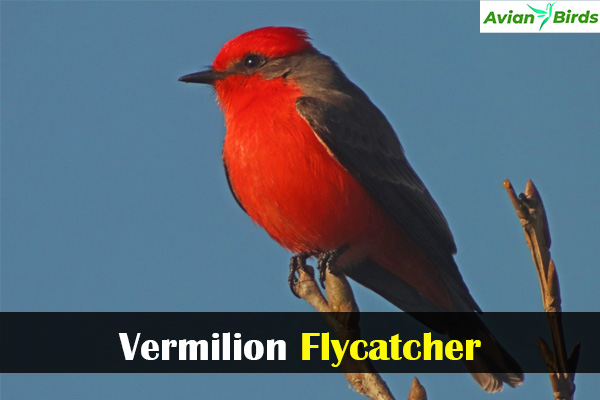
Visual Characteristics
The Vermilion Flycatcher is known for its bright red belly and brown back. This makes it a standout in Florida, especially in winter. Seeing them in their natural spots, like green and brown areas, shows off their beauty and uniqueness.
Feeding and Habitation
These red birds of Florida love to eat insects, and they catch them in mid-air with skill. This shows how agile and good at hunting they are. They live near streams, open woods, and scrubland, making these places great for seeing them in winter. Knowing where they live helps us understand their importance in nature and how to protect their homes.
5. House Finch
- Scientific Name: Haemorhous mexicanus
- Size: 14–18 cm (5.5–7.1 in) in length
- Weight: 16–28 g (0.56–1 oz)
- Lifespan: 3–9 years in the wild
- Diet: Seeds, fruits, and plant material
The House Finch brightens our backyards with its vibrant colors. These small songbirds are common in northern Florida. The male House Finch is known for its bright reddish feathers, which contrast with the female’s duller colors.

House Finches live in many human-made environments. They love our parks and homes. They eat seeds, especially sunflower and millet, making them a favorite among birdwatchers.
These red birds of Florida are social and often gather in small groups. They make beautiful sounds as they look for food. Watching them is interesting for those who like to learn about city wildlife. Feeding them seeds can make them feel welcome in our yards.
| Characteristic | Details |
|---|---|
| Size | Approximately 5 to 6 inches in length |
| Coloration (Male) | Bright red plumage on the head and chest |
| Coloration (Female) | Mottled brown and white |
| Habitat | Urban, suburban, and agricultural areas |
| Diet | Seeds and grains |
| Social Behavior | Often seen in small flocks |
Watching House Finches in our yards teaches us about city wildlife. They show us how nature can thrive in our spaces. Their presence adds joy to our lives.
6. Red-headed Woodpecker
- Scientific Name: Melanerpes erythrocephalus
- Size: 22–26 cm (8.7–10.2 in) in length
- Weight: 70–100 g (2.5–3.5 oz)
- Lifespan: 4–10 years in the wild
- Diet: Insects, fruits, nuts, and seeds
The Red-headed Woodpecker is a standout in Florida’s woodpecker world. Its bright red head and black-and-white body grab attention. People who love birds and those who just like to watch them find it fascinating.
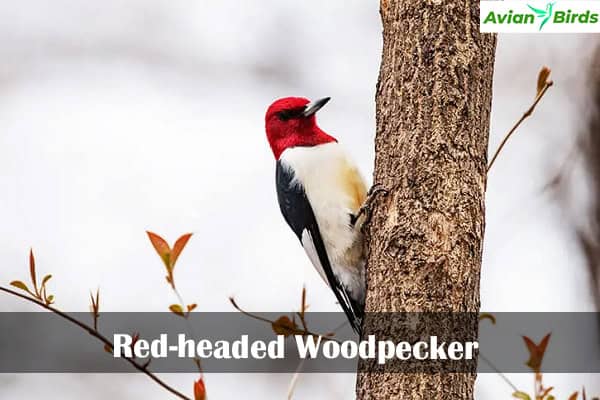
Its look is as interesting as its way of eating. We find this bird’s eating habits really cool.
Unique Feeding Behavior
This woodpecker is special because of how it eats. It likes to store food, which helps it survive. Unlike many birds, it eats insects, fruits, and seeds.
It searches for food on tree trunks and branches. Watching it find its next meal is quite a sight.
| Feeding Habits | Description |
|---|---|
| Food Sources | Insects, fruits, seeds |
| Storing Behavior | Hides food in tree crevices |
| Foraging Techniques | Drilling, pecking, and gleaning |
| Preferred Habitat | Forests, swamps, and open woodlands |
Learning about the Red-headed Woodpecker makes us appreciate it more. It shows us how important these birds are in their homes. Watching their unique behaviors makes birdwatching more interesting.
7. Painted Bunting
- Scientific Name: Passerina ciris
- Size: 12.5–13.5 cm (4.9–5.3 in) in length
- Weight: 9–20 g (0.32–0.71 oz)
- Lifespan: 3–6 years in the wild
- Diet: Seeds, fruits, and insects
The Painted Bunting, known as Passerina ciris, is a standout among Florida’s birds. Males display vibrant blue and red, like a painter’s palette. Their nesting and migration patterns, along with their diet, make them fascinating.
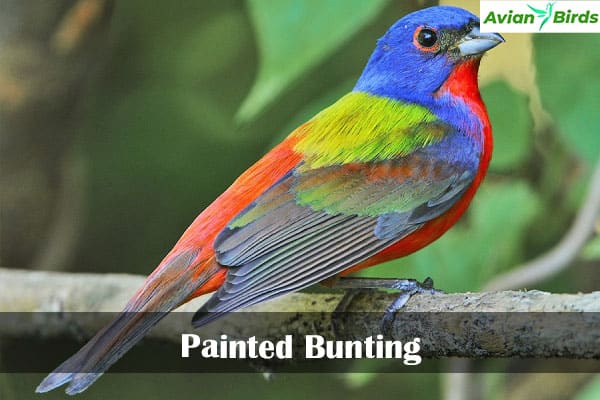
Nesting and Migratory Patterns
In late spring to early summer, the Painted Bunting breeds in dense shrubbery and trees. Their nests are hidden, protecting them from predators. They migrate to warmer areas in Mexico and Central America for the cold months.
Diet and Feeding Habits
These red birds of Florida eat seeds but prefer insects during breeding season. Their varied diet helps them live in different places. We often see them at feeders or on the ground, looking for seeds.
| Aspect | Details |
|---|---|
| Scientific Name | Passerina ciris |
| Typical Habitat | Weedy fields, shrublands, and wood edges |
| Nesting Period | Late spring to early summer |
| Migratory Behavior | Leaves for Mexico and Central America in late summer |
| Main Diet | Seeds and insects |
8. Purple Finch
- Scientific Name: Haemorhous purpureus
- Size: 16–18 cm (6.3–7.1 in) in length
- Weight: 18–25 g (0.63–0.88 oz)
- Lifespan: 3–5 years in the wild
- Diet: Seeds, fruits, and insects
The Purple Finch, known as Haemorhous purpureus, is a sight to behold with its bright raspberry-red feathers. Males shine with this vibrant color. Females have a more subtle look, with brown streaks. They live in northern Florida, from forests to city gardens.
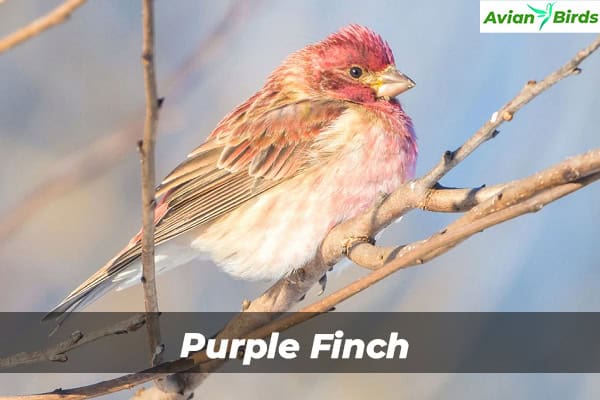
In winter, these birds visit our bird feeders often. They eat seeds and sometimes fruits. Feeding them sunflower seeds, thistle, and other seeds can help us see them more.
They love to be around others, forming small groups. By offering food and a nice place to live, we can make our yards a haven for them in winter.
9. Red-bellied Woodpecker
- Scientific Name: Melanerpes carolinus
- Size: 23–25 cm (9–10 in) in length
- Weight: 70–100 g (2.5–3.5 oz)
- Lifespan: 4–12 years in the wild
- Diet: Insects, fruits, nuts, and seeds
The Red-bellied Woodpecker, known as Melanerpes carolinus, often flies under the radar in Florida’s bird world. Its colors might not pop out at first glance. But, it has special features that make it stand out. The bright red patch on its neck is a key way to tell it apart from other woodpeckers in Florida.

You can spot the Red-bellied Woodpecker in many places, like woods, parks, and even in suburbs. It’s good at living in different places, showing how it can eat a wide variety of foods. They eat insects, fruits, and nuts, using their strong beaks to get food from trees and other spots.
Learning about the Red-bellied Woodpecker shows how vital it is to our ecosystem. They help keep insect numbers in check and spread seeds around. Seeing them means our environment is healthy, making them a key part of Florida’s bird life.
| Characteristic | Details |
|---|---|
| Scientific Name | Melanerpes carolinus |
| Identification | Red nape, muted body colors |
| Habitat | Woodlands, parks, suburbs |
| Diet | Insects, fruits, nuts |
| Role in Ecosystem | Insect control, seed dispersal |
10. Rose-breasted Grosbeak
- Scientific Name: Pheucticus ludovicianus
- Size: 20–23 cm (7.9–9.1 in) in length
- Weight: 40–50 g (1.4–1.8 oz)
- Lifespan: 3–7 years in the wild
- Diet: Seeds, fruits, and insects
The Rose-breasted Grosbeak is a bird that catches the eye, especially when it visits Florida during migration. We look forward to seeing these spring birds in Florida. They brighten our landscapes with their pink, black, and white feathers. Both birdwatchers and casual observers find joy in their presence.
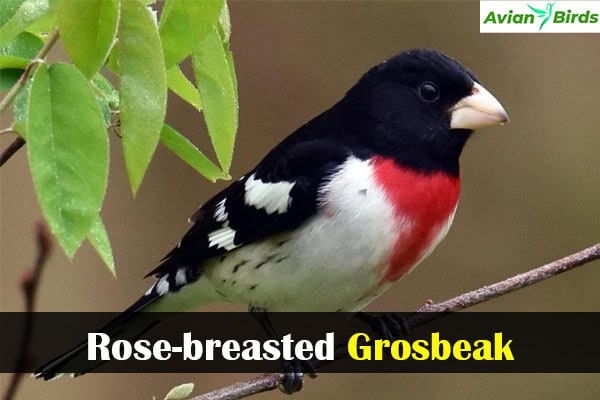
During their migration, these grosbeaks stop in Florida, often at feeders and in wooded areas. They like places with lots of food, eating seeds and insects. This helps them build up their energy for the next part of their journey.
The Rose-breasted Grosbeak’s migration patterns change with the seasons. In spring, we get to see these birds, signaling a change and adding color to our skies. Their travels teach us about bird migration and the beauty of nature.
Other Birds 🐦Found in Florida:
| Small Green Birds in Florida |
| Small Brown Birds In Florida |
| Green Birds in Sarasota Florida |
| White Birds with Long Beaks in Florida |
| Black Birds In Florida |
Conclusion
As we finish our look at Red Birds in Florida, we see the great birdwatching chances here. From the stunning Northern Cardinal to the beautiful Painted Bunting, these birds capture the hearts of many. Each one has its own special charm and is a key part of Florida’s wildlife.
We’ve looked at the traits, homes, and ways of these birds. Spotting a Scarlet Tanager or watching a Red-headed Woodpecker can be thrilling. These moments let us connect with nature and learn more about our world.
We urge nature fans to check out their yards and local parks for these birds. Birdwatching in Florida adds joy to our lives and connects us with the state’s rich wildlife. Let’s keep celebrating the amazing red birds that fill our skies!

